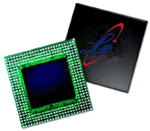 |
||
|
|
||
|
|
||
|
|
||
|
|
||
|
|
||
|
|
||
|
|
||
|
|
||
|
|
||
 |
|
|||
| Content Processor 5000 Product Brief |
 LeWiz's Content Processor 5000™ is designed for ease of use in intelligent network equipment. Generally, these systems are known as layer 4-7 smart switches or network equipment that enable network managers to implement functions such as traffic prioritization, traffic shaping, band-width allocation, access control and load balancing. The Content Processor processes layer 3-7 information in the network packets and redirects or filters the packets to allow the system to perform intelligent network functions. The processor executes these functions in hardware allowing the network equipment to perform network functions with the least latency and highest performance. LeWiz's Content Processor 5000™ is designed for ease of use in intelligent network equipment. Generally, these systems are known as layer 4-7 smart switches or network equipment that enable network managers to implement functions such as traffic prioritization, traffic shaping, band-width allocation, access control and load balancing. The Content Processor processes layer 3-7 information in the network packets and redirects or filters the packets to allow the system to perform intelligent network functions. The processor executes these functions in hardware allowing the network equipment to perform network functions with the least latency and highest performance.The content processor is implemented in deep sub-micron semiconductor technology. It consists of five major units: packet pre-processing, protocol parser, policy-based classifier, packet modification and forwarding engine, and system interface functions (See Figure 1). Note: Three of these units are logically grouped together as the packet processor and will be described together as one block in Figure 1. |
|
Features Delivery can be in the form of ASIC or as a PCI plug-in card Available for SoC integration (Verilog based code) Full software support with configuration and traffic management functions Complete traffic management system reference design using the content processor is also available Product Specifications  Packet Processor Three blocks of the content processor are grouped together and described below as the packet processor. These blocks include the system interface, the packet pre-processor, and the packet modification and forwarding engine. The packet processor receives the packets from the external system bus and processes the layer 3-4 (TCP/IP) of the network data packets on the fly. It disassembles the packets and sends the upper layer information to the protocol parser for upper layer protocol processing. The processor handles TCP/IP session termination and does session table walks for tracking of TCP/IP connections. The Content Processor 5000 interfaces to the external bus and controls the content processor's memory. The processor also controls the internal blocks of the content processor for the host to configure it. After the upper layer information is processed and classified, the results are fed into the packet processor for editing the packet and forwarding the packet on to its determined destination with the right QoS. If the packet is to be discarded the packet processor removes it from the queue. Protocol Parser The protocol parser receives the layer 5-7 data from the packet processor. It feeds the data through selected upper layer protocol processing blocks and identifies keywords required for forming the query to search in the policy database of the classifier. The parser can support various protocols including string based protocols such as HTTP, ebXML or binary based upper layer protocols. Classifier The classifier is a large policy, rules engine. It contains the policy database for classifying network traffic per flow. Query rule parameters from the parser are fed into the classifier for searching in the database. The result is used to redirect traffic with pre-determined QoS assignment or discard the packet. Packet processing block features: - Performs TCP/IP disassembly - TCP/IP session handling - Queuing of packets on the in-bound and the out-bound - Forwards layer 5-7 information to protocol parser - Edits the layer 3-4 information for fast forwarding of the packet - Reassembles the packet with the right QoS, destination - Generates new check sum, CRC - Discards the unwanted packets Protocol parser block features: Classifier block features: - TCP information such as source port, destination port - IP information such as source IP address, destination IP address - XML fields such as person name, action to be taken - URL, cookie information - etc. - Packet redirect - Packet discard, or filter - Packet prioritization, QoS assignment back to top |

